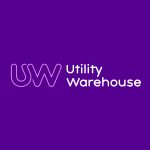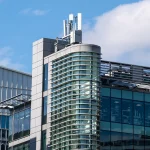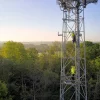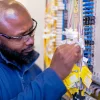EE Expand 5G Mobile to 500 Smaller UK Rural Towns and Villages

Consumer broadband ISP and mobile operator EE (BT) has today announced that their ultrafast 5G based (mobile broadband) network is expanding into more rural parts of the UK, reaching national parks, seasonal hotspots and over 500 smaller towns and villages. They’re also testing new technologies, such as mobile via LEO satellites.
At present EE’s 5G network already covers 60% of the UK’s “population” (mostly in urban areas), but they also aim to make it available “anywhere” in the UK by 2028 – through a combination of permanent coverage (90% of the UK’s landmass) and on-demand solutions (for the final 10%). The operator typically uses several different radio bands for this, such as 3.4-4GHz, 2100MHz and 700MHz (the deployed bands may differ between mast sites).
The change today, which has already started, is that their 5G network is now being deployed across more rural and semi-rural areas than before. Nearly 500 smaller communities, including Church Stretton and Birkenshaw in England, Llandeilo and Pen-y-banc (Carmarthenshire) in Wales and Tayport and Ratho in Scotland, now have their first 5G signal from EE. This brings the total number of UK cities, towns and villages where customers can access EE’s 5G to over 1,000.
Advertisement
As part of the rollout, EE’s 5G is also reaching National Parks and popular rural tourist destinations. Among seasonal hotspots seeing a 5G boost are Berwick-upon-Tweed and Windermere in England, Brecon (Aberhonddu), Dolgellau (Gwynedd) and Narberth (Pembrokeshire) in Wales, and Fort William in Scotland. The Brecon Beacons, Pembrokeshire Coast and The Broads are also named as the first National Parks to be getting the technology.
In relation to all this, BT has also begun testing a range of new technologies, which are intended to help EE boost the range, reliability and energy efficiency of its networks. We don’t get much detail on this, but you can find a simple summary below, and we’ve reported on some of these before.
BT / EE’s New Mobile Technology Trials
➤ UK’s first 4G sent over low earth orbit satellite:
BT Group has partnered with OneWeb to achieve the first transmission of 4G data using a low Earth orbit (LEO) satellite link to connect an EE mast to the mobile core network, instead of a traditional line of sight microwave or fibre connection. This paves the way for connecting small ultra-remote communities, emergency responders and disaster recovery units and other temporary deployments like festivals, events or construction sites.➤ Mobile coverage in harder to reach areas:
In collaboration with Stratospheric Platforms Ltd (SPL), BT Group is running a trial that aims to deliver mobile coverage from the air using a ‘High Altitude Platform’ (HAPS) system being tested at BT’s Global innovation centre (Adastral Park). This has the potential to unlock connectivity for the most remote areas.➤ Self-powering sites:
EE is weeks away from launching its first self-powering mast using sustainable energy, in Wales’ Elan Valley. Initial assessments demonstrate that local sourced renewable energy (wind and solar) can contribute up to 90% of the site’s requirements.➤ Biofuels phase-in:
Trials are commencing to test the use of biofuels like Hydrotreated Vegetable Oil (HVO), Biogas and Hydrogen in network generators to support wider resilience. EE will initially implement the solutions as a trial across 20 physical sites.
EE has also revealed that its older 4G network is “on track to pass 90% of the UK’s geographic landmass by the mid-2020s“, thanks in part to the investment made in network infrastructure, which is in line with its commitment under the £1bn industry-led Shared Rural Network (SRN) project with Vodafone, Three UK and O2 (VMO2).
The operator’s 4G network allegedly stretches more than 2,500 square miles further than the nearest challenger, with new 4G coverage added to nearly 50 locations every month over the past three years. The network also expects its landmark 1,500th upgrade under the SRN scheme to occur as early as next month.
Advertisement
Howard Watson, BT’s Chief Security and Networks officer, aid:
“The network rollout progress announced today is a critical step toward meeting our goal of enabling a 5G connection anywhere in the UK by 2028. The strength of our underlying 4G network, thanks in part to improvements made under the Shared Rural Network, has put us in the best position to make widespread 5G coverage improvements outside of big cities. Speaking as a technologist, I’m proud of the way BT Group is applying new innovations to reduce the digital divide.”
The only downside to this announcement is that we don’t get a comprehensive list of their rural 5G deployment plans, although naming so many locations could be a bit tedious.
Mark is a professional technology writer, IT consultant and computer engineer from Dorset (England), he also founded ISPreview in 1999 and enjoys analysing the latest telecoms and broadband developments. Find me on X (Twitter), Mastodon, Facebook, BlueSky, Threads.net and Linkedin.
« Ofcom UK Reviews Mid-Contract Broadband ISP Price Hikes UPDATE2





















































EE 5g and 4g coverage and speed very good. EE need to sort voice quality calls.
Calls drops and opposite person can’t hear property.
It’s not just voice calls (which are pretty bad) WiFi calling times out and drops the call after a set time and whilst 4g and 5g signals can seem strong in some ares, my experience of these is that they’re frequently over stretched and actually provide no useable bandwidth. This has been affecting me in multiple areas across multiple phones
You comment on every post about this. It’s just not true. Voice quality is excellent on EE
I can get EE 5G where I am even, according to their coverage checker. If they weren’t so expensive I may have considered it.
Hmm may have to check out their MVNO’s.
I was with Smarty and although cheap the network was terrible for me. EE seem a bit dearer (actually not that much for me) but I look at you pay more for a better network infrastructure.
Utility warehouse, 1p mobile and BT all offering 5G as a EE MVNO no word on plusnet offering yet but utility warehouse do a not to bad deal
Try 1p mobile on a data boost they use EE and much cheaper,and also only 1 month contract.i currently have 50gb data unlimited min / text for £15.00 a month.
@Declan M
Thank you for sharing 1p Mobile. I am in need of an extra SIM with just minutes and texts, so the £5 option for 1 GB of data sounds like an excellent choice. I am with EE already but any additional line still works out more expensive than that, even with their 10% discount.
For me, 5G is slower than 4G most of the time.
Because for whatever reason EE deployed 5G in my area (probably yours too) on band 1 on 10mhz wide channel.
But on 4G my phone can connect to Band3+B3+B7+B7 giving me speeds 3/4 times faster than 5G.
Does it make sense to deploy 5G on such a small bandwidth in areas where there’s so much 4G spectrum available?
@Gregowski
Purely to say that they did. There is no tangible benefit to the end user if LTE is faster for you. It is the same situation for me.
Declan M Utility Warehouse still dont offer 5g with their mobile sim, they keep on pushing it back. Can check their own site
https://uw.co.uk/services/mobile
My mistake I thought they did
I’d be happy with any mobile signal. There’s none on any of the networks inside the house or even in the garden.
Welcome to rural Northumberland!
Maybe EE should firstly get their main 3G/4G coverage sorted first, as well as providing somewhat decent value for money plans, before touting about what they’re doing with 5G!
I left EE for Vodafone and the latter are performing better in terms of overall coverage where I need it the most. They’re not as fast but if you need sheer speed, go for 3 instead with their 100MHz 5G bandwidth instead.
That depends where you need the coverage, for me Vodafone and O2 are the worse networks with Three in second place and EE offering easily 3 times what Vodafone and O2 can offer.
Vodafone and O2 are so oversubscribed that their 4G services are usually not worth it, thankfully EE has invested where I need it and I don’t have the issue.
As to them sorting out their coverage, I’ve used EE pretty much all over the UK and it constantly provides a decent service and in places it loses signal, it’s a damn sight faster regaining it again than any of the other big 4.
Random rural location: Holt Norfolk.
Three has 5G (was a very unexpected announcement a few months back), EE not yet.
Three and EE share a mast in the town, which has a upscale population of retirees/second homes/others, and a public school, so Holt should be on a target list for EE. Yes some less well off people live in Holt as well–but I would assess Holt as being nearly as affluent as Burnham (up)Market.
And yes, because Three has coverage, Smarty and ID also have coverage in Holt.
Signal (let alone 5G coverage) around Cambridge and suburbs is still absolutely shocking considering Cambridge’s culture, demographic and size.
(talking about EE here – perfect example is around Clifton Road and the south end of the central train station: no data or voice at all. Shocking for a city centre. Another example is around Cherry Hinton – virtually no voice or data).
Funny as I was on EE, I still am but on the 1pmobile mnvo and the number of times I had to go to Cambridge for work purposes, I never encountered any issues with EE in Cambridge.
Indeed in rural areas of Cambridgeshire, I’ve found EE to be heads above the competition where they are usually the only ones providing fast 4G, the others provide 3G or mind numbing slow 4G.
Still a large part of Telford not covered by EE 5G, yet they say Telford is ‘done’. I am sure there are multiple examples of this around the country with multiple operators.
However, their 4G in the 4G only areas can reach over 100Mbps where needed, which begs the question… why does rural areas need 5G? Correctly configured 4G would do just as well and in the case of the 5G (excluding 700mhz) go further.
Seems Marketing have more sway sometimes with some network operators than actual practical sense.
Wow! We refarmed 10mhz of one of our bands to NR, That really counts as 5G, trust us!
-EE marketing department.
I am with EE for my home broadband, 4G and 5G is really fast here at Croydon town centre. You look at around 200 mbs on 4G and 350 on 5G. Very happy to dump my Adsl provider.
I guess thats where coverage and reliability versus sheer speed comes in. On Three in that same area you can get around 600mbps to 1gbps speeds.
The fastest I’ve ever seen on Three was 1,126mbps by Tooting Broadway tube station
It’s a pity they seem to have forgotten what the S in SRN stands for, very little progress here solving the partial not-spots that plague Devon.
SRN is a joke in Cotswolds Gloucestershire, the masts are being rejected by council and local communities, at least another 6 rejected at planning stage, I thought SRN was the “Golden Solution”. Perhaps networks are partially to blame , taking to long to apply for planning, people are now aware and are very anti mast now!
@Mark
We don’t really need many ‘all new’ masts here in Devon, the problem is most of them are still single operator, meaning lots of partial not-spots.
There is a clear difference between what UK MNOs claim for coverage and what exists in reality.
Also, presence of signal does not always equate to having a workable service.
Levels of service do change with time – a drive test in Coastal Cornwall may demonstrate reasonable service, yet a similar test carried out in August will show a very different picture.
What is required is an independant way of continuously assessing service levels (proof of coverage AND proof of bandwidth) against which to assess MNO performance. Without a clear mapping of where the problem areas exist, it is not possible to deal with the coverage Not Spots!
One of the biggest issues with the Shared Rural Network Project is that it is only deploying new infrastructure in areas where the MNOs admit there are issues, so if you are located in a Not Spot that is already ‘claimed’ as covered, there will be no improvement as a result of SRN.
My little old rural mast in Aberdeenshire has been showing 5G for months now. It’s not on the EE coverage map (they say it is non Stand-alone 5G) it’s a basic tower with 3 antenna & all it has is 20MHZ of band 3. It has not had any physical upgrades. Only one of the 3 antenna gives a 5G signal. Speed tests are the same as they are on 4G.
Are EE doing this so they appear to have more 5G coverage than they actually do?
Stephen – when you say that your rural mast has been ‘showing’ 5G, I take it that your phone is displaying a 5G Stats Indicator (5G SI).
This does not necessarily mean that there *is* a 5G NR signal detected – it does mean that the UpperLayerIndication (as specified in 3GPP Release-15) is is being broadcast as TRUE in the SIB-2 broadcast.
For the chapter and verse on this – see https://blog.3g4g.co.uk/2019/09/when-does-your-5g-nsa-device-show-5g.html
In summary, it is possible for operators to make devices display the 5G Status Indicator – even when there is absolutely no 5G radio channels deployed! The result is that people get the impression that there *is* a 5G service present – even where there is not…..
A small investment of time and money setting up an Android device with *Network Signal Guru* will reveal the true picture! (Or get Peter Clarke or one of his young followers to do a survey for you).
Hi James
Yes that’s exactly what’s happening, people are getting excited that they have 5G when actually they don’t.
Thank you for the information, I will try to get my head round this!!
Sadly I don’t have any 5g Android devices, might have to try & pick up a cheap one.
We live in new ferry and the signal is poo in and outside until you get on main road come on impove this long time bt mobile customer
A list sure would be nice.
They’ve had a mobile mast near Alness without power for months and no time scale on it being fixed